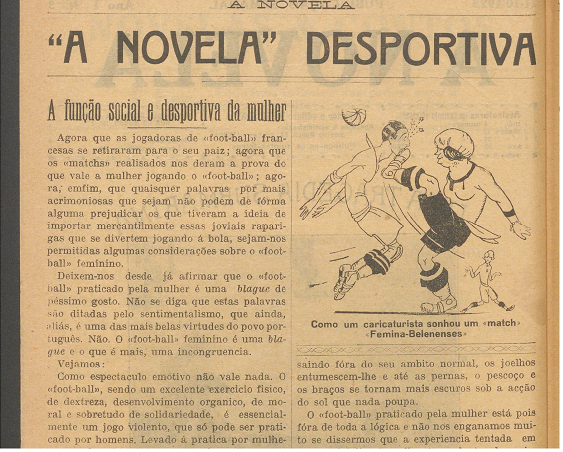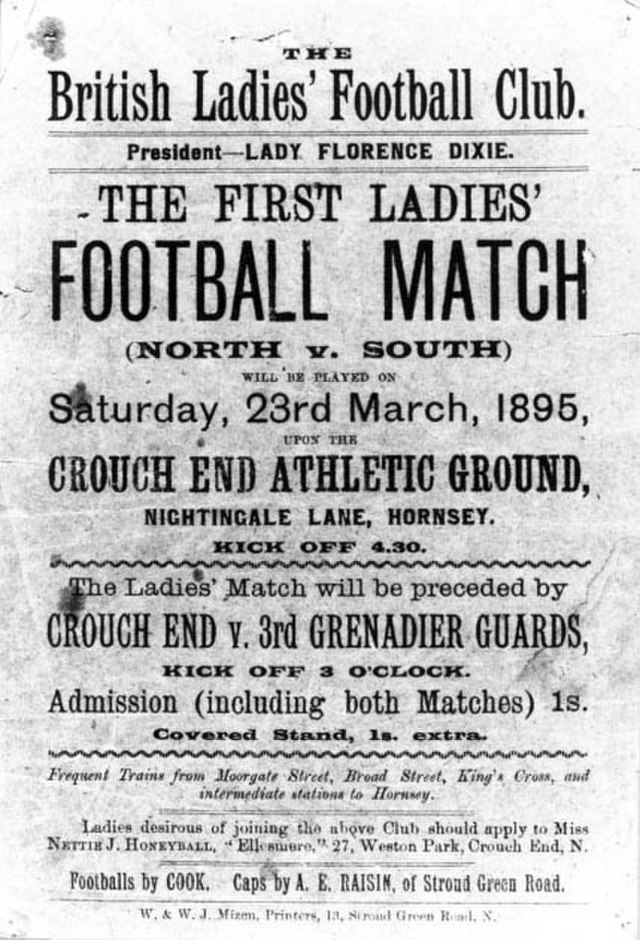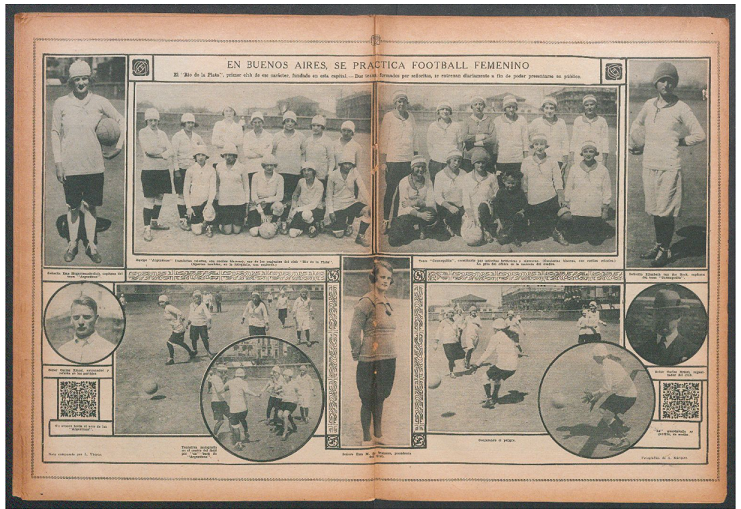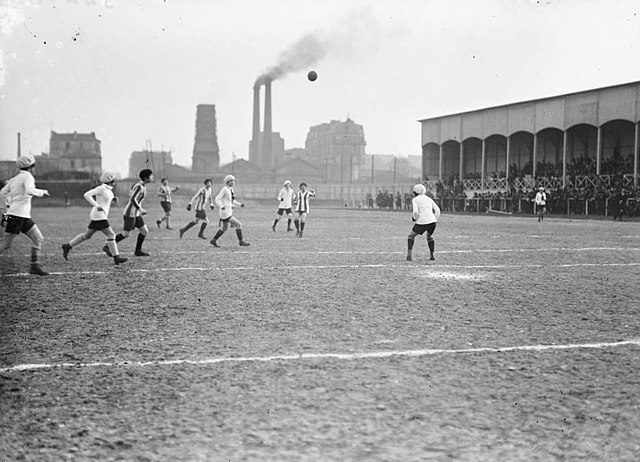After giving an insight into women’s sports in cultural magazines and showing how tennis, and in particular Suzanne Lenglen, influenced the social acceptance of female athletes, this article explores how soccer and other sports that were seen as “male sports” were portrayed in magazines at the beginning of the twentieth century.
The following article was written in a Portuguese magazine in 1923 judging women on their social function as athletes, after witnessing a female soccer game. It depicts how soccer was supposed to be played only by men, on the basis that it was a violent sport and its virility and energy would be incompatible with the nature and social function of women, as well as their grace and naïve charm. According to the article, the most important role women had to play in society was: care-takers who live at home, for their children, for their husband and for love(-making). [1] While tennis, swimming and horse riding were accepted, given that those sports would flatter the female body, the author suggested that women’s soccer is a blague, a joke, suggesting that their game was weak, imprecise and they would not be able to control the ball. [2]

The European countries were pioneers in the history of female soccer, having established the first English Football Association in 1863. Particularly interesting is the fact that the clubs, in this case the English clubs, wanted women to join the male teams in order to improve the behavior of the men, which turned out to be effective, nonetheless the female presence was heavily criticized by the all-male establishment. Against all odds, women’s soccer gradually became popular. During World War I, societies all over Europe drastically changed, creating more opportunities for soccer-playing women to continue with their passion. The return of the men after the war was a real setback for women’s soccer. Its popularity – a match in 1920 in Liverpool took place between two female teams in front of 53.000 people – was perceived as even more of a threat to men.[3] Therefore, women’s soccer was banned in the UK, leading to prohibitions in other countries as well. After Italy and France created women’s soccer leagues, the sport’s perception improved, but the UK ban was only lifted in 1971. Strangely enough, it was not until the 1996 Olympics in Atlanta that women’s soccer became an Olympic event. [4]


First ladies football match north v south 1895 (Public domain – no copyright )
In Latin America that situation was not preferable either. In Brazil, the first documented female soccer game took place in 1921 between Cantareira and Tremembé , although rather as an entertainment event during the celebrations of São João. This type of amusement game started to gain more popularity, just as in Europe, triggering a short, but rather violent debate in the public sphere if women should be allowed to play such an “aggressive” sport. Even physicians intervened, arguing that soccer would not suit the genetic predisposition of the female “soul “. Consequently, it was also banned and women’s right to play was only restored in 1979. Some teams started to arrange self-organized championships, which were only accepted by the Football-Association in 1983.[5]
Female soccer in Brazil started to really emerge in 1997, when Susana Werner, ex-spouse of Ronaldo, established a female team made up of models. The team was able to participate in shows, inter alia TV-Shows, thereby achieving more visibility, albeit not due to the women’s athletic performance but their beauty and appearance. It was like a parade of beautiful blond models on the lawn. [6]

The situation in Argentina was hardly different. With the arrival of British immigrants in Argentina, soccer became the most popular sport, also played in schools. Argentinian society at that time was predominantly composed by men, accounting for 2/3 of the inhabitants. In the Fray Mocho (1923, no. 597 :22) we see the first two female teams, who played against each other for the first time shortly after the article was published. Soccer was not mentioned negatively in the magazine, because this decade – 1920-1940 – was the Golden Age of highly competitive recreational sports and soccer became the national sport of the Argentinians, although only for men. [7] The debate in Argentina about “male sports” for the female body arose simultaneously with the European and was socially scorned and associated with lesbianism and uncontrolled sexuality. [8]
Nonetheless, there is another article in an Argentinian magazine, which emphasizes that women’s role in society had somewhat evolved. The author argues that, befitting their new and more equitable position, women should practice sports, because it would also help them manage other tasks more productively, given that they would dispose of more energy and better health to do so. According to him, the fact that women engage in all kind of sports, even soccer, attests to the increased equality between the genders. However, in the end he makes female sports all about meeting men, since sports areas/courts are “the perfect place for interconnecting with other people”.[9]

Mundo argentino, 1925, no. 761 :15


The only other article on women practicing „male-sports” found in our Collection of Latin American Cultural Magazines is the following paragraph on the boxer Luisa Adler from California, who was the world champion in middleweight boxing in her days. The article does acknowledge her talent, but seems to significantly emphasize her relationship to men, mocking her to have knocked out her husband both physically and then “by divorce”. It goes on recommending her to find another man in order to forget about her sport.[10] Incidentally, 90% of contemporary women who practiced any kind of sport, even as coaches or teachers, did not find a husband.[11]

The textual components of this post were published under the CC-BY-NC-ND license. The submitted images are property of the Ibero-American-Institute in Berlin and are protected by copyright laws or from a public domain with no copyright.
Bilbiography
Curi, Martin (2013). Brasilien – Land des Fußballs. Verlag die Werkstatt GmbH: Göttingen.
Dorfman Knijnik, Jorge (2003). A mulher brasileira e o esporte: seu corpo, sua história. São Paulo: Editoria MacKenzie.
Garton, Gabriela (2019). Guerreras – Fútbol, mujeres y poder. Argentina: Capital Intelectual S.A.
Hardy, James. (September 15, 2016) Goal: The Story of How Women’s Soccer Rose to Fame, History Cooperative, https://historycooperative.org/goal-the-story-of-how-womens-soccer-rose-to-fame/. Accessed November 9, 2021.
Simkin, John (1997). History of Women’s Football. 1997-2020 Spartacus Educational. Publishers Ltd. URL: https://spartacus-educational.com/Fwomen.htm. Accessed: November 11, 2021.
A Novela. (1923). No.3
A Novela. (1923). No.2
Fray mocho. (1923). No. 597
Mundo argentino (1925). No. 761
[1] A Novela, no.3 :2
[2] A Novela, No.3 :2
[3] Simkin
[4] Hardy, p.1
[5] Curi, p. 119
[6] Curi, p. 119
[7] Dorfman, p. 53
[8] Garton, p.30 ff.
[9] Mundo argentino, 1926, no. 792 :8
[10] Mundo argentino, no. 798 :22
[11] Dorfman, p. 51




